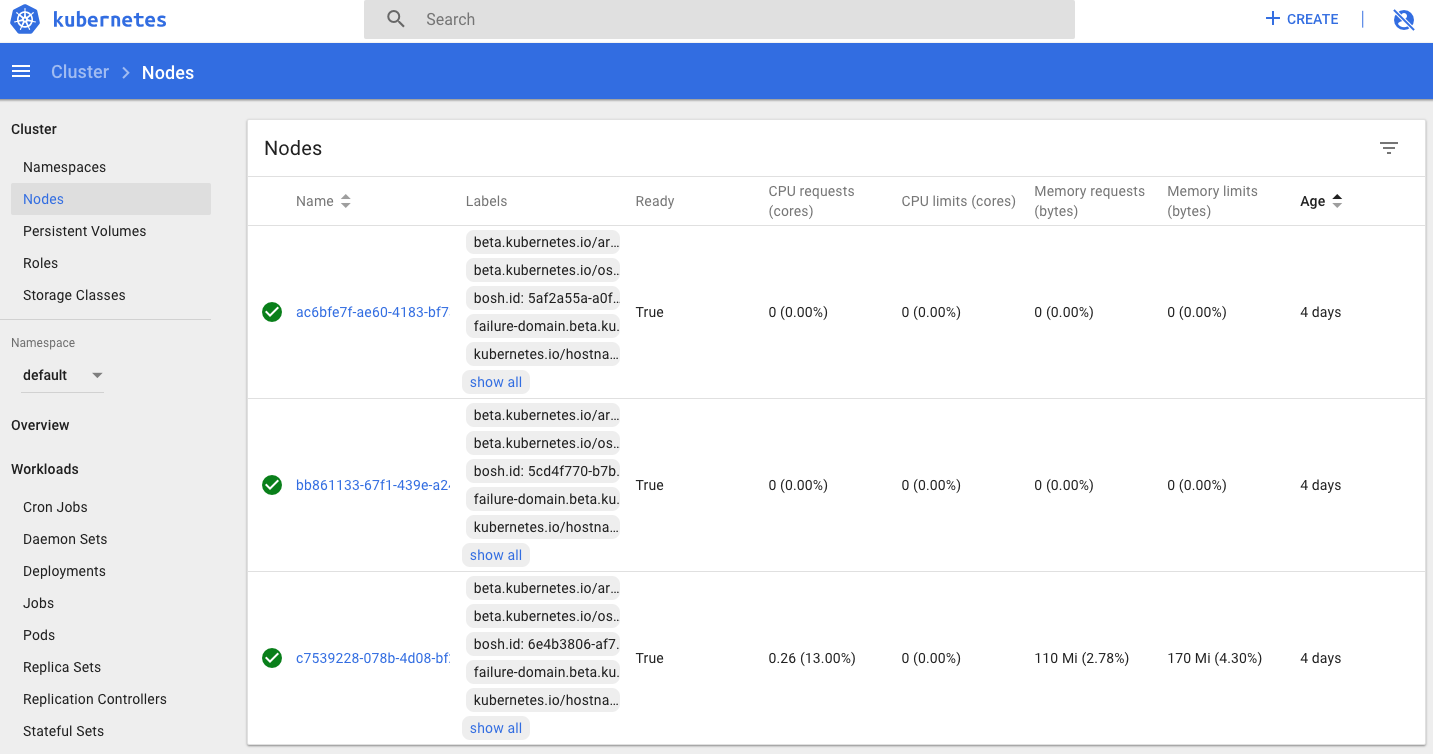A Read Only Kubernetes Dashboard
I’ve been working extensively with a new PKS customer recently, and one of the challenges we face is helping newbies understand whats happening in their K8S cluster. One of the best ways to do that is with ‘anchoring’ - giving them something that looks like what they know, so they can start to relate.
One of the ways we’ve done that is with the Kubernetes Dashboard - having something that looks familiar has been valuable to get engineers to a state where they feel comfortable about whats happening as part of their kubectl apply sequences. It certainly looks nice:

However, there’s a challenge…the default configuration for the dashboard does not give it permissions to see anything within the cluster. The dashboard page acknowledges this and suggests simply binding the dashboard service account to cluster-admin…YIKES:
apiVersion: rbac.authorization.k8s.io/v1beta1
kind: ClusterRoleBinding
metadata:
name: admin-user
roleRef:
apiGroup: rbac.authorization.k8s.io
kind: ClusterRole
name: cluster-admin
subjects:
- kind: ServiceAccount
name: admin-user
namespace: kube-system
Ugh! Thats not OK. Better would be a read only user…like the ‘view’ ClusterRole:
 But there’s a problem - the view ClusterRole doesn’t actually have permissions for the Cluster level objects like Nodes and Persistent Volume Claims. So we’ll have to create a new RBAC config.
But there’s a problem - the view ClusterRole doesn’t actually have permissions for the Cluster level objects like Nodes and Persistent Volume Claims. So we’ll have to create a new RBAC config.
First, we’ll create a new dashboard-viewonly ClusterRole:
---
apiVersion: rbac.authorization.k8s.io/v1
kind: ClusterRole
metadata:
name: dashboard-viewonly
rules:
- apiGroups:
- ""
resources:
- configmaps
- endpoints
- persistentvolumeclaims
- pods
- replicationcontrollers
- replicationcontrollers/scale
- serviceaccounts
- services
- nodes
- persistentvolumeclaims
- persistentvolumes
verbs:
- get
- list
- watch
- apiGroups:
- ""
resources:
- bindings
- events
- limitranges
- namespaces/status
- pods/log
- pods/status
- replicationcontrollers/status
- resourcequotas
- resourcequotas/status
verbs:
- get
- list
- watch
- apiGroups:
- ""
resources:
- namespaces
verbs:
- get
- list
- watch
- apiGroups:
- apps
resources:
- daemonsets
- deployments
- deployments/scale
- replicasets
- replicasets/scale
- statefulsets
verbs:
- get
- list
- watch
- apiGroups:
- autoscaling
resources:
- horizontalpodautoscalers
verbs:
- get
- list
- watch
- apiGroups:
- batch
resources:
- cronjobs
- jobs
verbs:
- get
- list
- watch
- apiGroups:
- extensions
resources:
- daemonsets
- deployments
- deployments/scale
- ingresses
- networkpolicies
- replicasets
- replicasets/scale
- replicationcontrollers/scale
verbs:
- get
- list
- watch
- apiGroups:
- policy
resources:
- poddisruptionbudgets
verbs:
- get
- list
- watch
- apiGroups:
- networking.k8s.io
resources:
- networkpolicies
verbs:
- get
- list
- watch
- apiGroups:
- storage.k8s.io
resources:
- storageclasses
- volumeattachments
verbs:
- get
- list
- watch
- apiGroups:
- rbac.authorization.k8s.io
resources:
- clusterrolebindings
- clusterroles
- roles
- rolebindings
verbs:
- get
- list
- watch
And then bind it to the service account:
---
apiVersion: rbac.authorization.k8s.io/v1beta1
kind: ClusterRoleBinding
metadata:
name: kubernetes-dashboard
labels:
k8s-app: kubernetes-dashboard
roleRef:
apiGroup: rbac.authorization.k8s.io
kind: ClusterRole
name: dashboard-viewonly
subjects:
- kind: ServiceAccount
name: kubernetes-dashboard
namespace: kube-system
Now we’ve configured a readonly dashboard we can safely share with people that dont even have K8S cluster access (many devs dont - they just push via a CI/CD pipeline). As a side note, this RBAC config does NOT grant access to Secrets, just to be a little safe.
And voila:
